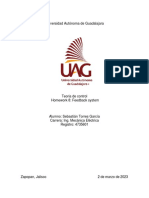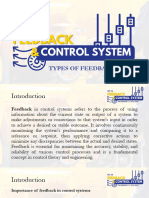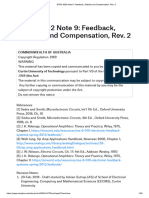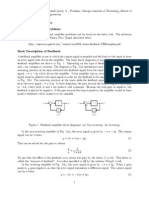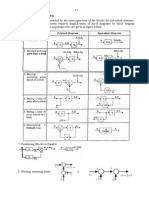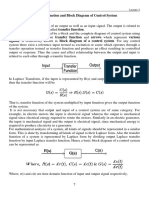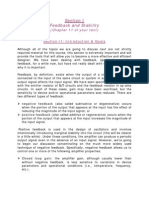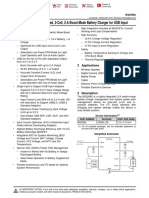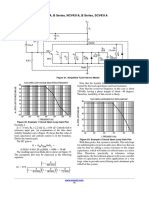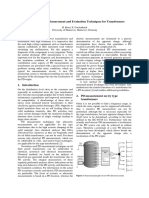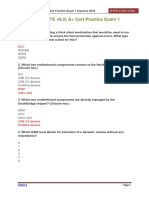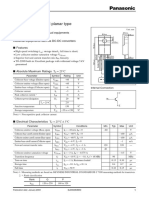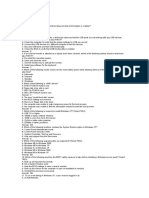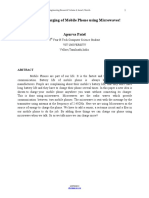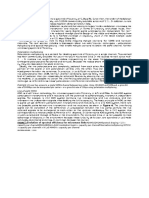ECEN 2260
Supplementary notes on
Introduction to Negative Feedback
and Control Systems
R. W. Erickson
1.
Introduction
Let us consider the common generic problem of causing a network to produce a
given desired output signal. A typical block diagram is illustrated in Fig. 1. We are able to
select the input vin(s) arbitrarily, and it is desired to produce a certain specified output
vout(s). The problem is that there is an unwanted disturbance vd(s) which also affects the
vd(s)
output. We have no control over v d(s), and
disturbance
vd(s) varies over some range. Also, the
values of the circuit elements are
G2(s)
constructed to a certain tolerance (such as
10%), and so
in high-volume
vout(s)
v (s)
manufacturing of the system, the numerical in
++
G1(s)
input
output
values of the transfer function G1(s) lie in
some distribution. Several examples of
Fig. 1. Block diagram of a generic system.
simple systems of this form will be
discussed in class, including an op-amp circuit, a positioning system for computer
peripherals or robotics, and a spacecraft solar array power system. You will construct a
solar array shunt regulator system in lab, in which the solar array output voltage is kept
constant in spite of variations in sunlight intensity or payload current.
So we cannot expect to simply apply one input waveform vin(s), and obtain the
specified output waveform vout(s) under all conditions. The idea behind the use of negative
feedback is to build a circuit that automatically adjusts the input vin(s) as necessary, to
obtain the desired vout(s) with high accuracy, regardless of disturbances in vd(t) or
variations in component values. This is a useful thing to do whenever there are variations
and unknowns that otherwise prevent the system from attaining the desired performance.
�ECEN2260 Supplementary notes on Negative Feedback
vd(s)
disturbance
Original system
G2(s)
compensator
vref(s)
reference
input
ve(s)
error
signal
Gc(s)
vin(s)
++
G1(s)
original
input
H(s) vout(s)
vout(s)
output
H(s)
sensor output
Fig. 2. Addition of negative feedback to the system of Fig. 1, to cause the output vout to follow a
reference input vref, and to be insensitive to disturbances vd.
A block diagram of a feedback system is shown in Fig. 2. The output signal vout(s)
is measured, using a sensor with gain H(s). When the output signal is a voltage, the
sensor circuit may simply be a voltage divider, comprised of precision resistors. In systems
where the output is some other physical quantity, the sensor may be a transducer that
produces a voltage proportional to the output quantity. The sensor output signal H(s)vout(s)
is compared with a reference input voltage vref(s). The objective is to make H(s)vout(s)
equal to vref(s), so that vout(s) accurately follows vref(s) regardless of disturbances vd(s) or
component variations in G1(s) or G2(s).
The difference between the reference input vref(s) and the sensor output H(s)vout(s)
is called the error signal v e(s). If the feedback system works perfectly, then vref(s) =
H(s)vout(s), and hence the error signal is zero. In practice, the error signal is usually
nonzero but nonetheless small. Obtaining a small error is one of the objectives in adding a
compensator network Gc(s) as shown in Fig. 2. Note that the output voltage vout(s) is equal
to the error signal ve(s), multiplied by the gains Gc(s) of the compensator and G1(s) of the
original system. If the compensator gain Gc(s) is large enough in magnitude, then a small
error signal can produce the required output voltage vout(t) (Q: how should H(s) and vref(s)
then be chosen?). Compensators are also used to improve the transient response and
stability of the system. So a large compensator gain leads to a small error, and therefore the
output follows the reference input with good accuracy. This is the key idea behind negative
feedback systems.
In the following sections, the effects of feedback on the transfer functions of the
system are determined. The loop gain T(s) is defined as the product of the gains in the
�ECEN2260 Supplementary notes on Negative Feedback
forward and feedback paths of the feedback loop. It is found that the transfer function from
a disturbance to the output is multiplied by the factor 1/(1+T(s)). Hence, when the loop
gain T is large in magnitude, then the influence of disturbances on the output voltage is
small. A large loop gain also causes the output voltage vout(s) to be nearly equal to
vref(s) / H(s), with very little dependence on the gains in the forward path of the feedback
loop. So the loop gain magnitude || T || is a measure of how well the feedback system
works. All of these gains can be easily constructed using the graphical construction
method; this allows easy evaluation of the important closed-loop transfer functions.
Stability is another important issue in feedback systems. Adding a feedback loop
can cause an otherwise well-behaved circuit to exhibit oscillations, ringing and overshoot,
and other undesirable behavior. An in-depth treatment of stability is beyond the scope of
these notes; however, the simple phase margin criterion for assessing stability is briefly
discussed here. When the phase margin of the loop gain T is positive, then the feedback
system is stable. Moreover, increasing the phase margin causes the system transient
response to be better-behaved, with less overshoot and ringing. The relation between phase
margin and closed-loop response is quantified in section 4.
2.
Effect of negative feedback on the network transfer functions
The original system, Fig. 1, can be represented by the following equation:
vout(s) = G1(s) vin(s) + G2(s) vd (s)
(1)
where
G1(s) = original open-loop transfer function from vin(s) to vout(s).
G2(s) = original open-loop transfer function from vd(s) to vout(s).
Thus, in the original system the output vout(s) is related to vin(s) and vd(s) according to the
open-loop transfer functions G1(s) and G2(s).
Let us reduce the block diagram of Fig. 2, to determine how the addition of
negative feedback modifies the transfer functions from vin(s) and vd(s) to vout(s). Figure 3
illustrates the simplification of Fig. 2, using the rules for reducing block diagrams. In Fig.
3(a), the blocks G1(s) and Gc(s) are combined. The second summing node is pushed to the
left in Fig. 3(b). The feedback loop is reduced in Fig. 3(c). The summing node is pushed
to the right in Fig. 3(d), yielding the final result.
�ECEN2260 Supplementary notes on Negative Feedback
a)
vd(s)
G2(s)
vref(s)
vout(s)
++
Gc(s) G1(s)
H(s)
b)
vd(s)
G 2(s)
G c(s) G 1(s)
vref(s)
vout(s)
++
Gc(s) G1(s)
H(s)
c)
vd(s)
G 2(s)
G c(s) G 1(s)
vref(s)
+
+
G c(s) G 1(s)
1 + G c(s) G 1(s) H(s)
vout(s)
d)
vd(s)
G 2(s)
1 + G c(s) G 1(s) H(s)
vref(s)
G c(s) G 1(s)
1 + G c(s) G 1(s) H(s)
+
+
vout(s)
Fig. 3. Steps in the simplification of the system of Fig. 2, using the rules for manipulating block
diagrams.
�ECEN2260 Supplementary notes on Negative Feedback
The original open-loop block diagram of Fig. 2 is of the same form as the closedloop block diagram of Fig. 3(d). Hence, the effect of the addition of negative feedback on
the transfer functions from vin(s) and vd(s) to vout(s) can now be determined. Figure 3(d)
predicts that the output is
vout(s) = vref (s)
G1(s)Gd (s)
G2(s)
+ vd(s)
1 + G1(s)Gd(s)H(s)
1 + G1(s)Gd(s)H(s)
(2)
which can be written in the form
vout(s) = vref (s)
with
G2(s)
T(s)
1
+ vd(s)
H(s) 1 + T(s)
1 + T(s)
(3)
T(s) = H(s)G1(s)Gd(s) = loop gain
Equation (3) is a general result. The loop gain T(s) is defined in general as the product of
the gains around the forward and feedback paths of the loop. This equation shows how the
addition of a feedback loop modifies the transfer functions and performance of the system,
as described in detail below.
2.1.
Feedback reduces the transfer functions from disturbances to the
output
The original open-loop transfer function from vd(s) to vout(s) is given in Eq. (1) as
G2(s). According to Eq. (3), addition of feedback causes this transfer function to become
vout(s)
vd (s)
=
v in = 0
G2(s)
1 + T(s)
(4)
So this transfer function is reduced via feedback by the factor 1/(1+T(s)). If the loop gain
T(s) is large in magnitude, then the reduction can be substantial. Hence, the output voltage
variation vout(s) resulting from a given disturbance vd(s) is attenuated by the feedback loop.
The output impedance of a circuit can be viewed as the transfer function from
output current variations (which are effectively a disturbance) to the output voltage. So
voltage feedback also reduces the output impedance of a system by a factor of 1/(1+T(s)),
and the influence of output current variations on the output voltage is reduced.
2.2. Feedback causes the transfer function from the reference input to the
output to be insensitive to variations in the gains in the forward path
of the loop
The original open-loop transfer function from vin(s) to vout(s) is given in Eq. (1) as
G 1(s). The input to the closed-loop system of Fig. 2 is vref(s). According to Eq. (3), the
transfer function from vref(s) to vin(s) is
�ECEN2260 Supplementary notes on Negative Feedback
vout(s)
vref (s)
T(s)
1
H(s) 1 + T(s)
(5)
vd = 0
If the loop gain is large in magnitude, i.e., || T || >> 1, then (1+T) T and T/(1+T) T/T
= 1. The transfer function then becomes
vout(s)
vref (s)
1
H(s)
(6)
vd = 0
which is independent of Gc(s) and G 1(s). So provided that the loop gain is large in
magnitude, then variations in Gc(s) and G 1(s) have negligible effect on the output voltage
vout(s). Equations (5) and (6) apply equally well to dc values. For example, if vout and vref
are equal to the constant dc quantities Vout and Vref, then we can write
Vout
T(0)
= 1
1
Vref H(0) 1 + T(0) H(0)
(7)
So to make the dc output voltage Vout accurately follow the dc reference V ref, we need only
ensure that the dc sensor gain H(0) and dc reference Vref are well-known and accurate, and
that T(0) is large. Precision resistors are normally used to realize H, but components with
tightly-controlled values need not be used in Gc or G1. The sensitivity of the output voltage
vout to the gains in the forward path is reduced, while the sensitivity of vout to the feedback
gain H and the reference input vref is increased.
3.
Construction of the important quantities 1/(1+T) and T/(1+T) and the
closed-loop transfer functions
The transfer functions in Eqs. (3) (7) can be easily constructed using the graphical
construction method. Let us assume that we have analyzed the blocks in our feedback
system, and have plotted the Bode diagram of || T(s) ||. To use a concrete example, suppose
that the result is given in Fig. 4, for which T(s) is
1 + s
z
T(s) = T0
1+
s + s
p1
Q p1
1 + s
p2
(8)
�ECEN2260 Supplementary notes on Negative Feedback
80dB
|| T ||
QdB
| T0 |dB
60dB
fp1
40dB
40dB/dec
20dB
fz
20dB/dec
0dB
fc
fp2
crossover
frequency
20dB
40dB/dec
40dB
1Hz
10Hz
100Hz
1kHz
10kHz
100kHz
Fig. 4. Magnitude of the loop gain example, Eq. (8).
This example appears somewhat complicated. But the loop gains of practical voltage
regulators are often even more complex, and may contain four, five, or more poles.
Evaluation of Eqs. (4) and (5), to determine the closed-loop transfer functions, requires
quite a bit of work. The loop gain T must be added to 1, and the resulting numerator and
denominator must be re-factored. Using this approach, it is difficult to obtain physical
insight into the relationship between the closed-loop transfer functions and the loop gain. In
consequence, design of the feedback loop to meet specifications is difficult.
Using the graphical construction method, the closed-loop transfer functions can be
constructed by inspection, and hence the relation between these transfer functions and the
loop gain becomes obvious. Let us first investigate how to plot || T/(1+T) || . It can be seen
from Fig. 4 that there is a frequency fc, called the crossover frequency, where || T || = 1.
At frequencies less than f c , || T || > 1; indeed, || T || >> 1 for f << f c . Hence, at low
frequency, (1+T) T, and T/(1+T) T/T = 1. At frequencies greater than f c , || T || < 1,
and || T || << 1 for f >> fc. So at high frequency, (1+T) 1 and T/(1+T) T/1 = T. So we
have
T 1
T
1+T
for || T || >> 1
for || T || << 1
(9)
The asymptotes corresponding to Eq. (9) are relatively easy to construct. The lowfrequency asymptote, for f < f c , is 1 or 0dB. The high-frequency asymptotes, for f > f c ,
follow T. The result is shown in Fig. 5.
So at low frequency, where || T || is large, the reference-to-output transfer function
is
vout(s)
T(s)
= 1
1
1
+
T(s)
H(s)
H(s)
vref (s)
(10)
�ECEN2260 Supplementary notes on Negative Feedback
80dB
60dB
fp1
40dB
|| T ||
20dB
crossover
frequency
fz
fc
20dB/dec
0dB
fp2
T
1+T
20dB
40dB/dec
40dB
1Hz
10Hz
100Hz
1kHz
10kHz
100kHz
Fig. 5. Graphical construction of the asymptotes of
|| T / (1 + T) ||. Exact curves are omitted.
This is the desired behavior, and the feedback loop works well at frequencies where || T || is
large. At high frequency (f >> fc) where || T || is small, the reference-to-output transfer
function is
vout(s)
T(s)
T(s)
= 1
= Gc(s)G1(s)
H(s)
H(s)
1
+
T(s)
vref (s)
(11)
This is not the desired behavior; in fact, this is the gain with the feedback connection
removed (H 0). At high frequencies, the feedback loop is unable to reject the
disturbance because the bandwidth of T is limited. The reference-to-output transfer function
can be constructed on the graph by multiplying the T/(1+T) asymptotes of Fig. 5 by 1/H.
We can plot the asymptotes of || 1/(1+T) || using similar arguments. At low
frequencies where || T || >> 1, then (1+T) T, and hence 1/(1+T) 1/T. At high
frequencies where || T || << 1, then (1+T) 1 and 1/(1+T) 1. So we have
80dB
60dB
QdB
| T0 |dB
fp1
40dB
|| T ||
40dB/dec
20dB
fz
20dB/dec
0dB
+ 20dB/dec
fz
20dB
+ 40dB/dec
40dB
| T0 |dB
60dB
80dB
1Hz
fc
fp2
crossover
frequency
40dB/dec
1
1+T
fp1
QdB
10Hz
100Hz
1kHz
Fig. 6. Graphical construction of || 1 / (1 + T) ||.
10kHz
100kHz
�ECEN2260 Supplementary notes on Negative Feedback
1
1+T(s)
1
T(s)
for || T || >> 1
for || T || << 1
(12)
The asymptotes for the T(s) example of Fig. 4 are plotted in Fig. 6.
At low frequencies where || T || is large, the disturbance transfer function from vd(s)
to vout(s) is
vout(s)
G2(s)
G (s)
=
2
vd(s) 1 + T(s) T(s)
(13)
Again, G2(s) is the original transfer function, with no feedback. The closed-loop transfer
function has magnitude reduced by the factor 1/|| T ||. So if, for example, we want to reduce
this transfer function by a factor of 20 at 100Hz, then we need a loop gain || T || of at least
20 26dB at 100Hz. The disturbance transfer function from vd(s) to vout(s) can be
constructed on the graph, by multiplying the asymptotes of Fig. 6 by the asymptotes for
G 2(s).
Closed-loop output impedances of systems employing output voltage feedback can
be constructed in a similar manner. If the original (open-loop) output impedance is Zout(s),
then the closed-loop output impedance is Zout(s) / (1 + T(s)). The closed-loop output
impedance at low frequencies is
Z (s)
Z out(s)
out
1 + T(s)
T(s)
(14)
The output impedance is also reduced in magnitude by a factor of 1/|| T || at frequencies
below the crossover frequency.
At high frequencies (f > fc) where || T || is small, then 1/(1+T) 1, and
vout(s)
G2(s)
=
G2(s)
1
+ T(s)
vd(s)
Z out(s)
Z out(s)
1 + T(s)
(15)
This is the same as the original disturbance transfer function and output impedance. So the
feedback loop has essentially no effect on the disturbance transfer functions at frequencies
above the crossover frequency.
4.
Stability
It is well known that adding a feedback loop can cause an otherwise stable system
to become unstable. Even though the transfer functions of the original system, Eq. (1), as
�ECEN2260 Supplementary notes on Negative Feedback
well as of the loop gain T(s), contain no right half-plane poles, it is possible for the closedloop transfer functions of Eq. (3) to contain right half-plane poles. The feedback loop then
fails to regulate the system at the desired quiescent operating point, and oscillations are
usually observed. It is important to avoid this situation. And even when the feedback
system is stable, it is possible for the transient response to exhibit undesirable ringing and
overshoot. The stability problem is discussed in this section, and a method for ensuring
that the feedback system is stable and well-behaved is explained.
When feedback destabilizes the system, the denominator (1+T(s)) terms in Eq. (3)
contain roots in the right half-plane (i.e., with positive real parts). If T(s) is a rational
fraction, i.e., the ratio N(s)/D(s) of two polynomial functions N(s) and D(s), then we can
write
N(s)
D(s)
N(s)
T(s)
=
=
N(s) N(s) + D(s)
1 + T(s)
1+
D(s)
D(s)
1
1
=
=
N(s) N(s) + D(s)
1 + T(s)
1+
D(s)
(16)
So T(s)/(1+T(s)) and 1/(1+T(s)) contain the same poles, given by the roots of the
polynomial (N(s) + D(s)). A brute-force test for stability is to evaluate (N(s) + D(s)), and
factor the result to see whether any of the roots have positive real parts. However, for all
but very simple loop gains, this involves a great deal of work. A simpler method is given
by the Nyquist stability theorem, in which the number of right half-plane roots of (N(s) +
D(s)) can be determined by testing T(s) [1,2]. This theorem is not discussed here.
However, a special case of the theorem known as the phase margin test is sufficient for
designing most voltage regulators, and is discussed in this section.
4.1. The phase margin test
The crossover frequency fc is defined as the frequency where the magnitude of the
loop gain is unity:
|| T(j2fc) || = 1 0dB
(17)
To compute the phase margin m, the phase of the loop gain T is evaluated at the crossover
frequency, and 180 is added. Hence,
m = 180 + T(j2fc)
(18)
If there is exactly one crossover frequency, and if the loop gain T(s) contains no right halfplane poles, then the quantities 1/(1+T) and T/(1+T) contain no right half-plane poles when
10
�ECEN2260 Supplementary notes on Negative Feedback
the phase margin defined in Eq. (18) is positive. Thus, using a simple test on T(s), we can
determine the stability of T/(1+T) and 1/(1+T). This is an easy-to-use design tool we
simple ensure that the phase of T is greater than 180 at the crossover frequency.
When there are multiple crossover frequencies, the phase margin test may be
ambiguous. Also, when T contains right half-plane poles (i.e., the original open-loop
system is unstable), then the phase margin test cannot be used. In either case, the more
general Nyquist stability theorem must be employed.
60dB
The loop gain of a || T ||
T
|| T ||
40dB
fp1
typical stable system is
fz crossover
20dB
frequency
shown in Fig. 7. It can be
fc
T
0
0dB
seen that T(j2fc) = 112.
90
20dB
Hence, m = 180 112 =
+68. Since the phase margin
is positive, T/(1+T) and
1/(1+T) contain no right halfplane poles, and the feedback
system is stable.
The loop gain of an
unstable system is sketched
in Fig. 8. For this example,
T(j2fc) = 230. The
phase
margin
is
m = 180 230 = 50.
The negative phase margin
implies that T/(1+T) and
1/(1+T) each contain at least
one right half-plane pole.
40dB
180
270
1Hz
10Hz
100Hz
1kHz
10kHz
100kHz
Fig. 7. Magnitude and phase of the loop gain of a stable system.
60dB
The phase margin m is positive.
|| T ||
|| T ||
40dB
fp1
fp2
20dB
0dB
crossover
frequency
fc
0
90
20dB
40dB
180
m (< 0)
270
1Hz
10Hz
100Hz
1kHz
10kHz
100kHz
Fig. 8. Magnitude and phase of the loop gain of an unstable
system. The phase margin m is negative.
4.2. The relation between phase margin and closed-loop damping factor
How much phase margin is necessary? Is a worst-case phase margin of 1
satisfactory? Of course, good designs should have adequate design margins, but there is
another important reason why additional phase margin is needed. A small phase margin (in
T) causes the closed-loop transfer functions T/(1+T) and 1/(1+T) to exhibit resonant poles
with high Q in the vicinity of the crossover frequency. The system transient response
11
�ECEN2260 Supplementary notes on Negative Feedback
exhibits overshoot and ringing. As the phase margin is reduced these characteristics
become worse (higher Q, longer ringing) until, for m 0, the system becomes unstable.
Let us consider a loop gain T(s) which is well-approximated, in the vicinity of the
crossover frequency, by the following function:
T(s) =
s
0
1
1 + s
2
(19)
Magnitude and phase asymptotes are plotted in Fig. 9. This function is a good
approximation near the crossover frequency for many common loop gains, in which || T ||
approaches unity gain with
40dB
|| T ||
f0
T
|| T ||
f
a 20dB/decade slope, with
20dB
20dB/decade
f0
an additional pole at
0dB
f2
f0 f2
frequency f 2 = 2/2. Any
20dB
f2
additional poles and zeroes
0
40dB
40dB/decade
are
assumed
to
be
f
/
10
T
2
90
90
f2
sufficiently far above or
m
180
10 f2
below
the
crossover
270
frequency, such that they
f
have negligible effect on the
Fig. 9. Magnitude and phase asymptotes for the loop gain T of
Eq. (19).
system transfer functions
near the crossover frequency.
Note that, as f2 , the phase margin m approaches 90. As f2 0, m 0.
So as f2 is reduced, the phase margin is also reduced. Lets investigate how this affects the
closed-loop response via T/(1+T). We can write
T(s)
1
1
=
=
1
1 + T(s)
s2
s
1+
1
+
+
T(s)
0
0 2
(20)
using Eq. (19). By putting this into standard quadratic form, one obtains
T(s)
1
=
s
1 + T(s)
1+
+ s
Qc
c
12
(21)
�ECEN2260 Supplementary notes on Negative Feedback
where
c = 02 = 2 fc
0
Q = 0 =
2
c
So the closed-loop response contains
quadratic poles at f c , the geometric
mean of f0 and f2. These poles have a
low Q-factor when f0 << f 2 . In this
case, we can use the low-Q
approximation to estimate their
frequencies:
Q c = 0
c
= 2
Q
40dB
20dB
|| T ||
f0
f
20dB/decade
fc =
f0 f2
0dB
20dB
T
1+T
Q = f0 / f c
f0
f2
40dB
f0 f2
f2
40dB/decade
Fig. 10. Construction of magnitude asymptotes of the
closed-loop transfer function T / (1 + T), for the
low-Q case.
(22)
Magnitude asymptotes are plotted in Fig. 10 for this case. It can be seen that these
asymptotes conform to the rules of section 3 for constructing T/(1+T) by the algebra-onthe-graph method.
Next consider the high-Q case. When the pole frequency f2 is reduced, reducing the
phase margin, then the Q-factor given by Eq. (21) is increased. For Q > 0.5, resonant
f0
poles occur at frequency f c . The 60dB
magnitude Bode plot for the case
f2 < f0 is given in Fig. 11. The
frequency fc continues to be the
geometric mean of f2 and f 0 , and fc
now coincides with the crossover
(unity-gain) frequency of the || T ||
asymptotes. The exact value of the
closed-loop gain T/(1+T) at frequency
fc is equal to Q = f0 /fc . As shown in
|| T ||
40dB
20dB/decade
f2
20dB
Q = f0 / fc
0dB
T
1+T
20dB
fc =
f0 f2
f0 f2
f2
40dB
f0
40dB/decade
Fig. 11. Construction of magnitude asymptotes of the
closed-loop transfer function T / (1 + T), for the
high-Q case.
Fig. 9.12, this is identical to the value of the low-frequency 20dB/decade asymptote
(f0/f), evaluated at frequency fc. It can be seen that the Q-factor becomes very large as the
pole frequency f2 is reduced.
The asymptotes of Fig. 11 also follow the algebra-on-the-graph rules of section 3,
but the deviation of the exact curve from the asymptotes is not predicted by the algebra-onthe-graph method. These two poles with Q-factor appear in both T/(1+T) and 1/(1+T). We
need an easy way to predict the Q-factor. We can obtain such a relation by finding the
frequency at which the magnitude of T is exactly equal to unity. We then evaluate the exact
13
�ECEN2260 Supplementary notes on Negative Feedback
phase of T at this frequency, and compute the phase margin. This phase margin is a
function of the ratio f 0 /f 2 , or Q 2. We can then solve to find Q as a function of the phase
margin. The result is
Q=
cos m
sin m
1+
m = tan -1
1 + 4Q 4
2Q 4
(23)
This function is plotted in Fig. 12, with Q expressed in dB. It can be seen that obtaining
real poles (Q < 0.5) requires a phase margin of at least 76. To obtain Q = 1, a phase
margin of 52 is needed. The system with a phase margin of 1 exhibits a closed-loop
response with very high Q! With a small phase margin, T(j) is very nearly equal to 1 in
the vicinity of the crossover frequency. The denominator (1+T) then becomes very small,
causing the closed-loop transfer functions to exhibit a peaked response at frequencies near
the crossover frequency fc.
Figure 12 is the result for the simple loop gain defined by Eq. (19). However, this
loop gain is a good approximation for many other loop gains that are encountered in
practice, in which || T || approaches unity gain with a 20dB/decade slope, with an
additional pole at frequency f 2 . If all other poles and zeroes of T(s) are sufficiently far
above or below the crossover frequency, then they have negligible effect on the system
transfer functions near the crossover frequency, and Fig. 12 gives a good approximation
for the relation between m and Q.
20dB
Q
15dB
10dB
5dB
Q = 1 0dB
0dB
m = 52
-5dB
Q = 0.5 6dB
m = 76
-10dB
-15dB
-20dB
0
10
20
30
40
50
60
70
80
90
m
Fig. 12. Relation between loop gain phase margin m and closed-loop peaking
factor Q.
14
�ECEN2260 Supplementary notes on Negative Feedback
Another common case is the one in which || T || approaches unity gain with a
40dB/decade slope, with an additional zero at frequency f 2 . As f 2 is increased, the phase
margin is decreased and Q is increased. It can be shown that the relation between m and Q
is exactly the same, Eq. (23).
A case where Fig. 12 fails is when the loop gain T(s) three or more poles at or near
the crossover frequency. The closed-loop response then also contains three or more poles
near the crossover frequency, and these poles cannot be completely characterized by a
single Q-factor. Additional work is required to find the behavior of the exact T/(1+T) and
1/(1+T) near the crossover frequency, but nonetheless it can be said that a small phase
margin leads to a peaked closed-loop response.
4.3. Transient response vs. damping factor
One can solve for the unit-step response of the T/(1+T) transfer function, by
multiplying Eq. (21) by 1/s and then taking the inverse Laplace transform. The result for Q
> 0.5 is
vout(t) = 1 +
2Q e - ct/2Q
sin
4Q 2 1
4Q 2 1
c t + tan -1
2Q
4Q 2 1
(24)
For Q < 0.5, the result is
with
vout(t) = 1 2 e 1t 1 e 2t
2
1
1
2
c
2
1, 2 =
1 1 4Q
2Q
These equations are plotted
in Fig. 13 for various values
of Q.
According to Eq.
(21), when f 2 > 4f 0 , the Qfactor is less than 0.5, and
the closed-loop response
contains a low-frequency
and a high-frequency real
pole. The transient response
in this case, Eq. (25),
contains
decayingexponential functions of
time, of the form
(25)
Q=50
v(t)
Q=10
Q=4
1.5
Q=2
Q=1
Q=0.75
Q=0.5
Q=0.3
Q=0.2
0.5
Q=0.1
Q=0.05
Q=0.01
0
0
10
ct, radians
Fig. 13. Unit-step response of the second-order system, Eqs. (24)
and (25), for various values of Q.
15
15
�ECEN2260 Supplementary notes on Negative Feedback
Ae (pole) t
(26)
This is called the overdamped case. With very low Q, the low-frequency pole leads to a
slow step response.
For f2 = 4f 0 , the Q-factor is equal to 0.5. The closed-loop response contains two
real poles at frequency 2f 0 . This is called the critically damped case. The transient
response is faster than in the overdamped case, because the lowest-frequency pole is at a
higher frequency. This is the fastest response that does not exhibit overshoot. At ct =
radians (t = 1/2fc), the voltage has reached 82% of its final value. At ct = 2 radians (t =
1/fc), the voltage has reached 98.6% of its final value.
For f2 < 4f 0 , the Q-factor is greater than 0.5. The closed-loop response contains
complex poles, and the transient response exhibits sinusoidal-type waveforms with
decaying amplitude, Eq. (24). The rise time of the step response is faster than in the
critically-damped case, but the waveforms exhibit overshoot. The peak value of v(t) is
peak v(t) = 1 + e /
4Q 2 1
(27)
This is called the underdamped case. A Q-factor of 1 leads to an overshoot of 16.3%,
while a Q-factor of 2 leads to a 44.4% overshoot. Large Q-factors lead to overshoots
approaching 100%.
The exact transient response of the feedback loop may differ from the plots of
Fig. 13, because of additional poles and zeroes in T, and because of differences in initial
conditions. Nonetheless, Fig. 13 illustrates how high-Q poles lead to overshoot and
ringing.
5.
Summary of key points
1. Negative feedback causes the system output to closely follow the reference input,
according to the gain 1 / H(s). The influence on the output of disturbances and
variation of gains in the forward path is reduced.
2. The loop gain T(s) is equal to the products of the gains in the forward and feedback
paths. The loop gain is a measure of how well the feedback system works: a large
loop gain leads to better regulation of the output. The crossover frequency f c is the
frequency at which the loop gain T has unity magnitude, and is a measure of the
bandwidth of the control system.
3. The introduction of feedback causes the transfer functions from disturbances to the
output to be multiplied by the factor 1/(1+T(s)). At frequencies where T is large in
magnitude (i.e., below the crossover frequency), this factor is approximately equal
to 1/T(s). Hence, the influence of low-frequency disturbances on the output is
16
�ECEN2260 Supplementary notes on Negative Feedback
reduced by a factor of 1/T(s). At frequencies where T is small in magnitude (i.e.,
above the crossover frequency), the factor is approximately equal to 1. The
feedback loop then has no effect. Closed-loop disturbance-to-output transfer
functions, such as the line-to-output transfer function or the output impedance, can
easily be constructed using the graphical construction method.
4. Stability can be assessed using the phase margin test. The phase of T is evaluated at the
crossover frequency, and the stability of the important closed-loop quantities
T/(1+T) and 1/(1+T) is then deduced. Inadequate phase margin leads to ringing and
overshoot in the system transient response, and peaking in the closed-loop transfer
functions.
REFERENCES
[1] B. Kuo, Automatic Control Systems, New York: Prentice-Hall, Inc.
[2] J. DAzzo and C. Houpis, Linear Control System Analysis and Design: Conventional and Modern, New
York: McGraw-Hill Inc., 1995.
[3] R. D. Middlebrook, Measurement of Loop Gain in Feedback Systems, International Journal of
Electronics, vol. 38, no. 4, pp. 485-512, 1975.
[4] R. D. Middlebrook, Design-Oriented Analysis of Feedback Amplifiers, Proceedings National
Electronics Conference, vol. XX, October 1964, pp. 234-238.
17

